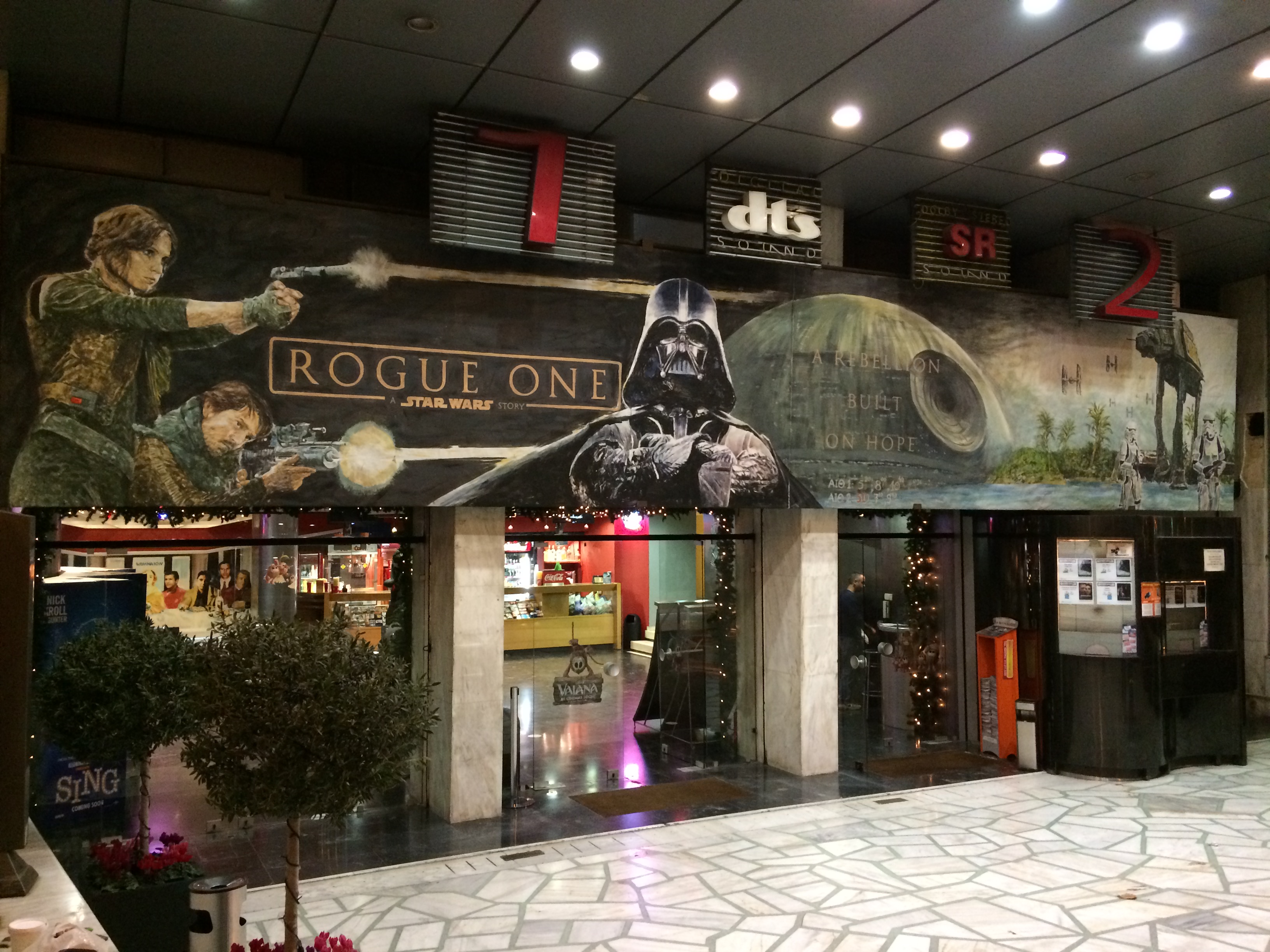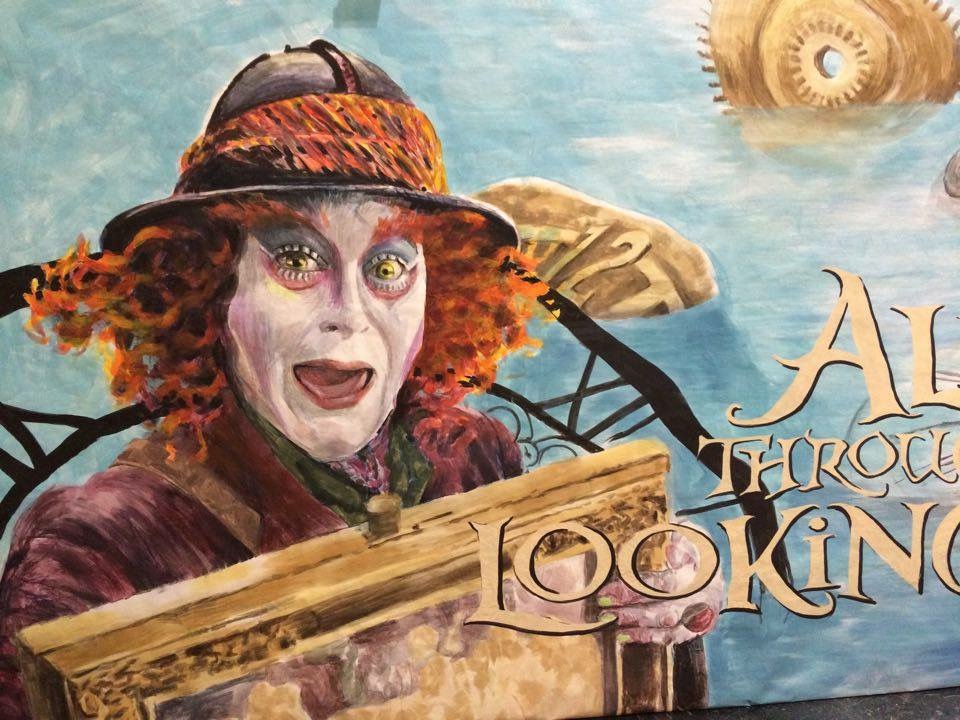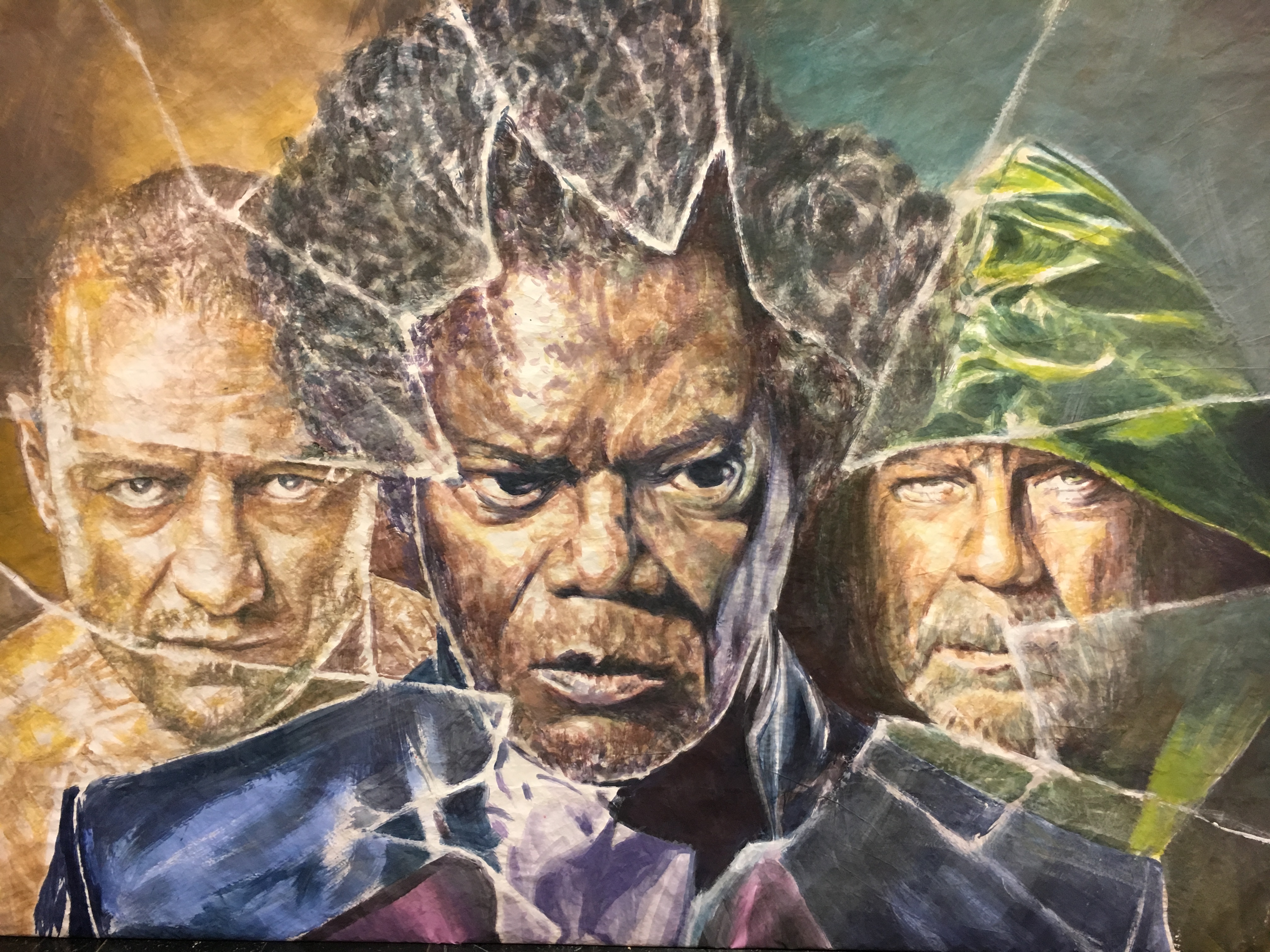Virginia Axioti’s art studio occupies a corner of her living room in her apartment in Athens, Greece. This is convenient, unless she is painting a poster for a thriller or horror movie. “With the movie It, it was not easy. [The poster] was six feet long, and it was looking over me. Those yellow eyes were glowing in the dark, and I was like, Oh fuck! Those times, I don’t fall asleep on the couch.”
Axioti, 42, is the last Greek producer of a dying art form: hand-painted movie posters. For the past five years she’s been the main artist for the Athinaion Cinema, which opened in Athens in 1960 and remains one of the oldest cinemas in the city, located in the central neighborhood of Ambelokipi. The 830-seat movie theater was founded by Axioti’s grandfather and great uncle, and is still a family business. (1) Each Wednesday, after the evening’s last show, the staff install the hand-painted billboards onto the marquee, advertising Greek and Hollywood films like Avengers: Endgame, A Star Is Born, and Little Women.
Last year, Axioti officially took over for Vasilis Dimitriou, now 84, a former boxer who lived through Greece’s Nazi occupation, military junta, and the civil war. He was a tremendously active artist, painting thousands of movie posters for the cinema for more than 40 years. As Dimitriou’s health began to falter a few years ago, Axioti slowly took over, the pair alternating weekly painting schedules. Axioti didn’t study under Dimitriou; she was already an established artist in her own right. She grew up in the cinema world and attended the Athens School of Fine Arts, where she learned to draw freehand and paint. Applying her skills to the posters was a natural progression.

We are used to seeing celebrities in high definition, poreless and digitized. But Dimitriou’s—and now Axioti’s—paintings hark back to a softer time, when faces were interpreted with an artist’s paintbrush. The colors of their paintings are warmer, and despite the meticulous freehand drawing, there’s a bit of human error that lends a palpability to the characters. Marvel superheroes—typically portrayed as tough and impenetrable—are slightly mellowed by Axioti’s deft hand. Suddenly, Iron Man becomes relatable.
“It’s more intimate, it’s more personal—each person will see it in a different way. It’s not the same as a [printed] poster. A painting is the hand gesture, the brushstroke, the movement,” Axioti said. “That’s the difference between the photo and the painting.”
Painting the posters is a time-consuming process. First, Axioti, who doesn’t have time to watch all the movies she’s hired to advertise, will watch trailers to get a sense of the film’s mood. She takes some creative liberties in her sketches, but usually relies heavily on the official poster. Then, using an opaque projector, she projects her drawing onto two huge pieces of paper and begins to mix her colors.
Each poster measures 20.3 feet by 7.2 feet and takes Axioti between three and five days to complete (for comparison, a standard movie poster is 2 feet by 3 feet). Because of the size of the painting, she constantly takes a few steps back, squinting at her work to make sure everything is properly scaled and making any necessary adjustments along the way. It’s a process similar to how movie posters were made in the mid 20th century—either through projection or with a large-scale grid.
“I don’t think anybody actually would consider letting go of this art, because we’ve grown up with it,” said Kostas Giannopoulos, Axioti’s cousin and a co-owner of the cinema. “To see the façade of Athinaion any other way but painted would feel totally not Athinaion.”

In the 1870s, the Parisian artist and lithographer Jules Chéret used a novel printing technique to create richly colored and textured posters. As films became more common through the end of the 19th century, cinemas began to use illustrated posters to promote movies, and the streets of Paris were awash with colorful signage. It is thought that the first poster to advertise a specific movie, the Lumière brothers’ 1895 film L’Arroseur arrosé, was illustrated by Marcellin Auzolle. The poster featured a colorful theater audience laughing at a black-and-white image of a gardener splashing water on his face. (The Lumière brothers, some of the first filmmakers in the world, are perhaps most famous for their movie L’Arrivée d’un train en gare de La Ciotat, which so rattled audiences that they ran out of the cinema, believing the train was going to burst out of the screen and into the theater.)
Film posters really took off in the 1910s, when silent movies became part of everyday entertainment, and production houses employed graphic designers to capture the glamour of the screen on paper. These were beautiful advertisements displayed on marquees at theaters and in the streets, meant to entice the audience into the air-conditioned, popcorn-fueled space. For most of the 20th century, hand-painted posters were the norm. In Greece, painters would work alone or in small teams, led by a principal painter, and sell their posters to multiple cinemas around the city.
But hand-painted posters are not unique to Europe or the United States. One of the most recognizable styles comes from Ghana, where artists would freehand Hollywood posters for local screenings at mobile cinema clubs, taking enormous artistic liberties with, say, Arnold Schwarzenegger’s face. To entice people into the cinema club, the poster artists would exaggerate the drama and action of a movie: In one Jurassic Park poster, a dinosaur is caught in mid-chew, a pair of bloodied legs dangling from its mouth. These posters, which had their heyday in the 80s and 90s, are now collector’s items.
Globally, the practice had mostly died out by the 70s and 80s, as production houses began to sell printed plastic posters to cinemas (though in Greece, Giannopoulos said, hand-painted posters were widespread as late as the early 2000s). And as theaters were confronted with a host of new competitors—video clubs, piracy, streaming services—many were forced to shut their doors or find ways to cut corners. From a financial perspective, hand-painted signs were a money pit for most cinemas.
“I don’t think Athinaion is ever going to use plastic billboards,” Axioti said. Giannopolous explained that the family’s love for the art of traditional cinema runs too deep. “It costs a little more, but we feel that it’s something that gives us part of our identity,” he said.

In a world where efficiency and money are worshipped at the twin altar of capitalism, there’s something exceedingly delightful about Athinaion’s insistence on labor-intensive, expensive posters. “A poster is a selling tool,” Tomasz Opasinski, a movie poster designer whose credits include I Am Legend and Oblivion, said during a master class on the subject in 2016. “It’s artistic, but it isn’t a piece of art. Your abstract poster may be beautiful, but if no one gets it, it goes nowhere.”
But the hand-painted poster on Athinaion’s marquee is exactly that—a piece of art, going nowhere. It serves no purpose, in a capitalist sense, other than to bring beauty into the world. “In the urban landscape, there is so little chance given to a painter’s hand, the human touch,” said Giannopoulos. “Everybody nowadays lives with images, on the phone or laptop or TV. It’s the only chance for someone to drive by Vasilis Sofias Avenue and have something different to take in. It’s not just that it’s unique, it’s that everyone gets a small breather in their everyday life with something that will bring him thoughts about a movie—these thoughts are generated by hand.” Indeed, these paintings are like a balm to the eyes—finally, something that doesn’t have the mark of a computer behind it.
Axioti has a more artistic viewpoint. “These posters have the same importance as the trees in the street,” she says. “It’s like bringing life into boxes.” (2)
1. Because of the COVID-19 pandemic, Greece officially went into lockdown on March 23, but the Athinaion, well aware that cinemas can easily spread the virus, decided to close in early March.
2.For an industry that is already struggling, coronavirus is another blow. At the time this issue went to print, the Athinaion’s doors remained closed. In March, Giannopoulos told VICE, “The posters aren’t going anywhere... But to be honest, I’m pretty worried that the soonest the Athinaion will be back into business will be in the fall.” He points to one bright spot for the summer season: open-air cinemas, which are prolific in Greece. Though it’s unclear whether open-air cinemas will be functioning in the summer season, for now, it’s a hope worth holding onto.
Follow Sarah Souli on Twitter.
from VICE https://ift.tt/2TCgW2o
via cheap web hosting
No comments:
Post a Comment